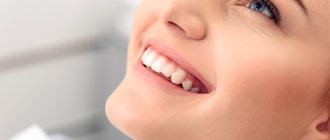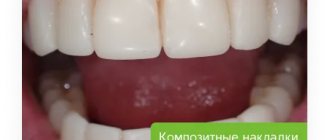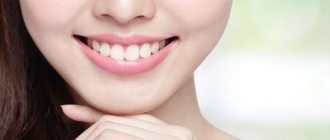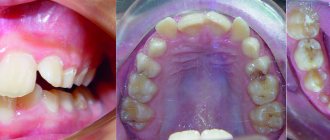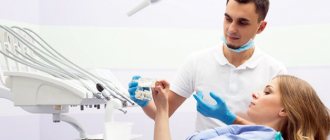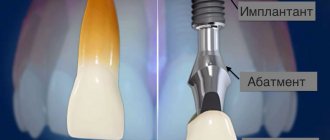Are your teeth too close together? Does this result in the formation of a dental arch shortened by several millimeters? Does this affect facial symmetry? Most likely, we are talking about crowded teeth. The problem lends itself to an effective orthodontic solution. If treatment is approached comprehensively, then in a few months the defect can be removed and you can boast of your beautiful and healthy teeth. What exactly should you pay attention to when treating dental crowding? Experts spoke about this.
Diagnosis of “crowded teeth” – what does it mean?
Dental crowding is a pathology characterized by close positioning and rotation of teeth. Because the teeth are too close together, some of them erupt outside the arch and overlap each other. This anomaly has several degrees of severity:
- mild
- when the crowding of teeth within one jaw is approximately 2-3 mm; - medium
- when it reaches 4-6 mm; - strong
- more than 7 mm.
Crowding can form on one or both jaws, as well as simultaneously in the anterior and lateral regions. In addition, the curvature, if left untreated, worsens over time, which leads to very sad consequences and requires more serious treatment. An interesting fact is that crowding of the lower teeth is several times more common than the upper teeth.
Degrees and symptoms of the disease
Orthodontists distinguish several degrees of crowding, each of which has its own characteristics of symptoms.
- The first (mild) degree is characterized by minor changes in the position of 1-2 dental units in a row.
- The average degree manifests itself as a significant displacement of 1-2 teeth. This can be a shift relative to the normal position, tilt or rotation around its axis. The amount of displacement does not exceed 5-6 mm.
- The third (severe) degree is characterized by significant deformation of the dentition, which is clearly visible to others when smiling and talking.
The greater the deformity, the more difficult oral care becomes. Changing the position of teeth contributes to the formation of hard-to-reach areas in which large amounts of plaque accumulate. This significantly increases the risk of caries, gingivitis, periodontitis and other dental diseases.
Main causes of the anomaly
Dental crowding occurs both at the level of the teeth and dentition, and due to improper development of the jaws. In the first case, the causes of its appearance are “eights”, as well as supernumerary teeth, or hyperdentia, and macrodentia - a pathology associated with an increase in the size of one or several teeth. "Eights", or third molars, appear quite late, at 16-27 years of age, and they often do not have enough space in the jaw. Once they erupt, they “pull” other teeth, which can cause crowding. The reasons for the formation of macrodentia and hyperdentia have not been fully studied, but most experts believe that it is a matter of heredity.
Often the cause of crowding is a small jaw - all the teeth simply cannot fit on it. Underdevelopment of the jawbone is influenced by early loss of teeth and lack of replacement, heredity, defects that arose during the formation of the fetus, as well as such bad childhood habits as infantile swallowing, mouth breathing and sucking of irregularly shaped pacifiers or bottles.
One of the bad childhood habits is worth talking about in more detail - this is the mouth type of breathing, which develops due to pathologies of the ENT organs. Outwardly it appears like this: the mouth is slightly open, the upper lip is upturned, the oval of the face is elongated; as it progresses, an adenoid type of face may form.
At first glance, a harmless habit negatively affects the condition of the child in general and the dental system in particular:
- the dentition on the sides narrows;
- little space for permanent teeth;
- the structures of the upper and lower jaw are not fully formed;
- weak tone of the orbicularis oris muscles;
- the dome of the sky becomes higher;
- the configuration of the nasal membrane is disrupted;
- problems with sound pronunciation, articulation;
- overload of the temporomandibular joint and the occurrence of facial muscle pain.
After treatment, such as adenoid resection, the habit of breathing incorrectly often remains. It is necessary to re-teach the child to breathe through the nose, constantly strengthen the orbicularis oris muscle and use an elastic trainer with a vestibular plate (2 times for 30 minutes during the day and at night). Regular exercises restore normal breathing within 3 months.
Anomalies formed at the jaw level are more difficult to correct, especially when it comes to adult patients - in such situations it is often necessary to sacrifice healthy teeth and resort to the help of an oral and maxillofacial surgeon.
Braces don't treat, doctors treat!
Therefore, if you:
- they suggested “putting braces” on, but you don’t have a clear understanding of why they need to be installed;
- did not carry out diagnostics (or carried it out superficially);
- they did not clearly and clearly describe the treatment plan for braces and its final result;
- they only talked about the technical side of the issue: “what kind of braces to put”, “sapphires are better than metal ones”, “internal braces are more invisible”, etc.;
- During the treatment process, they were suddenly informed that “pure braces” would not help - it was necessary to remove some teeth or undergo surgery on the jaws...
How to fix crowded teeth in children
The absence of spaces between the primary canines in a small child is a sure sign that there is not enough space in the jaw. And if even baby teeth can’t fit on it, then molars definitely won’t be able to fit either. Treatment at such a young age is usually not carried out, since it is difficult to force very young children to wear orthodontic appliances, even removable ones. However, it is during this period that one very important thing needs to be done - get rid of bad habits that cause crowding: wean the baby from sucking his finger and pacifier, teach him to swallow correctly and eliminate the cause of mouth breathing.
Treatment of crowding of the upper and lower teeth in the early mixed dentition, that is, starting from 6 years of age, is carried out with the help of plates, as well as trainers, LM-activators, palatal expanders and other functional devices. At this age, it is especially effective to correct the size and position of the jaws, but it is not always necessary to correct crowding during this period. Of course, it will be possible to straighten the dentition, but there is a high probability that they will return to their previous position after the remaining molars erupt. This is why many orthodontists recommend delaying treatment until 11-13 years of age, when the bite is fully formed.
A specialist can prescribe a young patient a set of myogymnastic exercises that normalize the functioning of the oral muscles. To achieve the necessary results, it is enough to devote only 7-10 minutes a day to gymnastics. This way you can avoid not only the development of malocclusion, but also problems with the musculoskeletal system in the child.
Examples of myogymnastic exercises
✔ Button.
Hold a large flat plastic button horizontally between your lips, first for 1 minute, then for 3-5 minutes.
✔ Ruler.
Press the edge of a ruler 8-10 cm long with your lips, while holding it horizontally. Next, increase the load by placing a small object on the ruler.
✔ Air.
With your lips closed, blow air first under the upper and then under the lower lip.
✔ Cheeks.
With your lips closed, puff out your cheeks, and then slowly squeeze out the air with your fists through your clenched lips.
To eliminate anomalies in adolescence, inexpensive designs are used - the price of ceramic braces is quite justified in terms of aesthetics and treatment effectiveness, and the most disciplined children are even fitted with aligners - removable transparent aligners that must be worn at least 22 hours a day. However, even at this stage, specialists are faced with certain difficulties in the form of wisdom teeth that have not yet appeared, so they are faced with a very important question - is it worth carrying out treatment before they erupt or not?
Correction of dental defects
Correction with braces. The main problem when installing braces for an adult is that his jaw is already fully formed. Sometimes, when getting braces, several teeth need to be removed.
Modern dentistry offers several options for fixed structures:
- Metal braces that quickly correct dental defects.
- Plastic braces are less noticeable, but they can be stained by food and break fairly quickly.
- Ceramic and sapphire braces have a beautiful appearance and withstand physical activity quite well, but the braces are very expensive.
Many patients are concerned about the aesthetic impression they will make on others when they appear with braces on their teeth. Such patients are offered structures that are installed on the teeth from the tongue side, so they become invisible to prying eyes.
Correcting crowded teeth with braces takes quite a long time (about a year), but here the patient has to sacrifice aesthetics and choose health benefits.
Crowding and wisdom teeth
There are many situations where the eruption of “eights” led to repeated crowding, but this is not at all a reason to refuse early correction of the anomaly. “Wise” teeth are formed by the age of 12, which allows you to see them in the picture and create a treatment plan taking into account the peculiarities of their eruption. Of course, if there is not enough space in the bone, experts prefer not to take risks and remove wisdom teeth in their infancy in order to avoid recurrence of crowding. Waiting for the “eights” to erupt is also not entirely reasonable, since they can appear either very late - around the age of 27, or remain retained. If there is enough space in the bone, wisdom teeth should not be removed - if they erupt correctly, they will be included in the chewing process.
Interesting fact!
Wisdom teeth are one of the rudiments of our body. They rarely participate in the bite, are not always formed and quite often - in about 20 - 25% of cases - remain impacted, that is, they do not erupt. Therefore, if a patient is indicated for tooth extraction due to their crowding, attention should be paid to the “eights” first.
Remember!
The general rules of treatment for any doctor, no matter whether he is a dentist or not, are the same and universal!
First, the essence of WHAT they are actually going to treat must be clear. As an example: we need to find out the cause of crowded teeth.
However, it should also be understood that the cause cannot be identified only by external examination. Comprehensive diagnostics required
After identifying WHAT the problem is before us, it becomes clear HOW, in principle, it can be solved.
Treatment strategy and tactics must be reflected in the treatment plan. He, in turn, should be as clear as possible. As well as the planned end result of treatment.
Only after this can you begin treatment directly.
Having established the true cause of the malocclusion, you will not be mistaken in choosing the treatment method and tools.
Treatment with braces
Braces can correct crowded teeth in both adulthood and adolescence. There are several options for eliminating crowding orthodontically:
➢
expansion of the dentition;
➢
separation (grinding the contact surfaces of teeth);
➢
distalization, that is, the movement of teeth towards the lateral ones;
➢
extraction (removal).
X-rays, in particular teleroentgenograms and computed tomography, help determine which treatment method is suitable in a particular clinical case. Using them, the specialist determines the volume and condition of the bone tissue, the type of gum, and based on the data obtained, draws up a plan for moving the teeth.
Important!
In order to avoid relapse, after removing braces, it is mandatory to wear a retainer - a thin plate that is attached to the lingual side of the teeth. The period of wearing it is twice as long as the duration of treatment.
Advantages and disadvantages of aesthetic correction
In terms of price, aesthetic dental restoration in Moscow may not be the cheapest pleasure. But on the other hand, veneers are quickly made and installed quite simply, while braces need to be worn for a long time, and after treatment is completed, you continue to use a removable orthodontic structure and retainers so that the teeth do not return to their previous position. In addition, those around you who are unaware of the intricacies of treatment will never notice that the teeth have been corrected with veneers. But the installed braces system cannot always be hidden from prying eyes.
However, this method also has disadvantages.
- The more the teeth are rotated around the axis, the more tissue will have to be ground off to install ceramic plates. Sometimes it is necessary to perform large-scale preparation, which increases the risk of damage to the pulp.
- When using veneers, it is quite difficult to perfectly match them to the natural tone of the ground tooth. Tooth enamel and the different layers of underlying dentin have different shades and varying degrees of transparency. They will noticeably affect the aesthetics of the tooth restored with a translucent plate, and a professional will easily notice the “substitution”.
Is it possible to fix teeth without braces?
Yes, but remember that veneers have a limited lifespan and will likely need to be replaced in the future.
Tooth extraction for overcrowding
Unfortunately, in some cases, it is not possible to treat crowding with braces without removing teeth. For example, it cannot be avoided when there is not enough space in the jaw for teeth to move. As we found out, the first candidate for removal is a wisdom tooth. However, even its absence does not guarantee the presence of space in the bone. In this case, experts recommend removing “fours” and sometimes “fives”. Removing even two teeth helps to “get” 6 to 8 mm of free space.
Another indication for extraction is supernumerary teeth and macrodentia. If they are removed at an early age, the dentition can take the correct position on its own and will not require orthodontic correction. However, at a later age you cannot do without it.
Diagnostics
Diagnosis of crowded teeth includes the following steps:
- visual inspection;
- X-ray diagnostics or orthopantomogram.
Additional diagnostic methods may be used:
- Pon's method - determining the width of the dentition.
- Corkhouse method - measuring the distance between the width of the incisors and the length of the frontal section.
- Snagina's method involves measuring the width of the crown, dental arch, and a line passing along the level of the apexes of the roots of the teeth (apical base).
Teeth crowding: treatment without braces
One of the most common alternative methods for treating crowding is separation - minimal grinding of the contact surfaces of the teeth, no more than 0.5 mm. Separation allows you to get up to 4 mm of free space, which in some situations is quite enough for leveling. During grinding, it is very important not to overdo it and not remove too much hard tissue, which can lead to increased sensitivity of the tooth.
In some cases, crowding is eliminated by installing veneers, lumineers and crowns. However, orthopedic structures can only be effective for minor curvatures. Otherwise, in order to install them, you will have to grind down the tooth, which will lead to extremely disastrous consequences.
Important!
Orthodontic structures will help correct the position of the teeth, but not their shape and size - veneers, lumineers or crowns are installed for these purposes.
What periods would I like to highlight in his emotions:
The first period of treatment for crowded teeth with aligners is “anxiety”
After installing the attachments and giving the patient the first set of aligners, I was faced with his slight anxiety about tooth sensitivity; the patient constantly asked me if it was normal that one or the other tooth was sensitive when biting (to which I replied that this was absolutely normal and this is a period of getting used to the aligners), but after the first week and the patient got used to the aligners, his anxiety also went away. Later, when changing each set of aligners to a new one, he was already calm about the slight sensitivity of his teeth in the first 2 days of wearing the new set.
The second period of treatment for the patient is “satisfaction, sharing impressions”
Subsequently, the patient was so pleased with the chosen treatment method that he constantly told me funny / incidental stories related to removing the aligners in a restaurant or on vacation, or brushing his teeth at work after eating:
- Once
I wrapped my aligners in a napkin in the cafeteria at work and they were taken away along with the tray and thrown away, the patient panicked, called me and asked what he should do?! I suggested either looking in the trash or ordering a new set, but in the end he, a colleague and a canteen worker found them in a trash container! HOORAY) - Second story
. I was on a business trip, went to a restaurant for lunch and didn’t take the container with me, took off the mouth guards before eating, put them on a napkin next to me (for some reason I took off the mouth guards right at the table), a family with children was sitting at the next table and the children began to laugh when they saw how he took off his mouthguards, telling his parents: “Look, the guy is taking off his dentures”:
After all, aligners are generally transparent and invisible
The third period of treatment for crowded teeth is “complete satisfaction”
Complete satisfaction is also supplemented by an assessment of how others perceive him - “how cool he is.” Yes, this is cool, treatment with aligners is invisible, aesthetic, every day it adds inner self-confidence to the patient, liberates the person and reveals his potential for communication with friends. This is really cool!
Fourth period of treatment. There is no more crowding of teeth: “I will be bored without aligners”
At the end of the treatment, the patient already said that he did not know how he would live after the aligners, that he would miss them and whether it was possible to continue wearing them after treatment. Do not take this literally, the patient just had a little anxiety - the fear of losing the result he was very satisfied with!
The patient began to smile and laugh much more often!
But this is important for me, as a treating orthodontist. The patient’s smile is the most important gratitude for my work.
Duration of treatment
Correcting crowding at the level of teeth and dentition takes from six months to two years, depending on the complexity of the clinical case. It is better to normalize the position and size of the jaws from childhood - with proper treatment, this will take no more than six months. In adults, it will not be possible to correct bone curvatures only with the help of orthodontic treatment - you will have to seek help from surgeons.
Interesting fact!
Typically, orthodontic treatment is performed on both jaws; in rare cases with slight crowding, treatment can be performed on one jaw.
My comment on this treatment:
I am satisfied with the result of the treatment and, probably, with the entire treatment process (even the slight anxiety and scrupulousness of the patient), it is nice to see in the end a satisfied, grateful and constantly laughing patient.
Is it possible to leave everything as is?
Firstly, crowded teeth are very difficult to clean, so caries often form in hard-to-reach places. Very often, its development proceeds unnoticed even by specialists, as a result of which the disease is detected already at the stage of acute inflammation, when not only the tooth is affected, but also the surrounding hard and soft tissues. It is not always possible to save such a tooth.
Secondly, crowded teeth can lead to malocclusion, wear, exposed roots, gum disease, which can result in tooth loss. Their loss (even if only one tooth is missing), as is known, complicates the process of chewing food, leads to disruption of the temporomandibular joint, and then the entire body. Therefore, we advise you not to delay orthodontic treatment and contact a specialist as soon as possible.
Prevention
Prevention of the development of crowding should be carried out from early childhood.
Already at the age of 3-4 years, it is necessary to make an appointment with an orthodontist, who will evaluate the development of the dental system. As a rule, if the teeth are cramped at the stage of primary occlusion, the situation will only worsen as they change to a permanent one. Wearing trainers and plates at this stage helps eliminate the defect. Orthodontists at the SM-Doctor clinic see both children and adolescents. We successfully solve even complex problems associated with incorrect position of teeth, selecting the optimal treatment method on an individual basis. Don’t wait until the violation becomes obvious, sign up for the SM-Doctor clinic.
Similar methods for correcting bites
There are certain alternatives to braces. For children, these are plates and trainers; for adult patients, these are aligners or Myobrace myofunctional trainers. The aligners are translucent and fit very tightly to the teeth, due to which they do not cause discomfort throughout the entire treatment period. In addition, the aligners are easily removable, which facilitates nutrition and hygiene procedures. Trainers for adults are removable devices, the main function of which is the correction of functional disorders of the elements of the oral cavity, as a result of which bite defects are corrected.
1 According to the scientific article Mkhitaryan A.R. “Why are so many people scared of braces?”, 1999.

